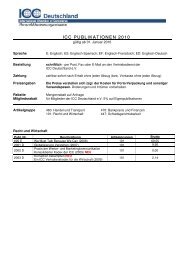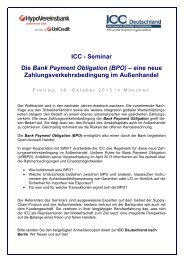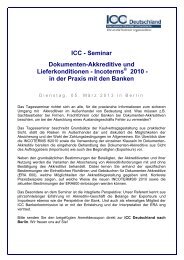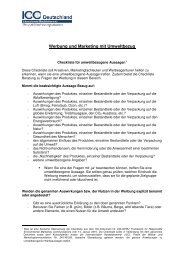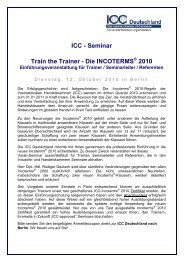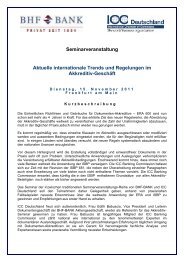Technical Vocational Training: A New Chamber ... - ICC Deutschland
Technical Vocational Training: A New Chamber ... - ICC Deutschland
Technical Vocational Training: A New Chamber ... - ICC Deutschland
Create successful ePaper yourself
Turn your PDF publications into a flip-book with our unique Google optimized e-Paper software.
Handwerkskammer Koblenz<strong>Technical</strong> <strong>Vocational</strong> <strong>Training</strong>:A <strong>New</strong> <strong>Chamber</strong> Servicein Sri LankaApplication for the World <strong>Chamber</strong>s Competition2011 in the section ‘Best International Project’Koblenz - GermanyFebruary 2011
Executive SummaryTogether with their local partners - the Federation of <strong>Chamber</strong>s of Commerce andIndustry of Sri Lanka (FCCISL) - Handwerkskammer Koblenz (Koblenz <strong>Chamber</strong> ofSkilled Crafts) have introduced technical vocational training as a unique chamberservice to Sri Lanka. In a joint, interdisciplinary, and intercultural effort we set up twovocational training centers, which today serve as a source of income for FCCISL,provide manpower to the construction industry of the country, and promote socialadvancement of different groups of people who previously had no opportunity for aqualified vocational training.Apart from the industry and individuals willing to finance their own training, socialorganisations and even the Government have realised the opportunity to use thesecenters for promoting qualification as a means of integration into society.Rather than importing all the necessary know-how and training concepts fromGermany, the project used local and German expertise alike, building on thesubstantial work previously done in Sri Lanka by the Government and internationalorganisations in the field of vocational training. This led to a training concept which isunique in its flexibility while following well-defined and established standards.The project has added a completely new role to the chambers in Sri Lanka, therebystrengthening their role in society as they contribute to qualification and job creation.We believe that the project is special in several ways, among them its multiple-donorstructure, cost-effectiveness and the flexible application of best practices as definedby UNESCO-UNEVOC in technical vocational education. However, its maininnovations lie in the concept of mobilising the business community’s institutions forvocational training, benefitting the companies and society alike, as well as theunique way of organising and especially financing training in a market-orientedfashion.Therefore, this project could not only serve as a role model for chambers andbusiness organisations worldwide, but also inspire new concepts of vocationaltraining projects in the context of development cooperation.Note: Althought this project was implemented by two major partners, it has beenjointly decided that this application is made by Handwerkskammer Koblenz (theKoblenz <strong>Chamber</strong> of Skilled Crafts) alone, as the Federation of <strong>Chamber</strong>s ofCommerce and Industry of Sri Lanka (FCCISL) would like to have the chance tocompete with one of their projects in another category in the 2011 competition.<strong>Technical</strong> <strong>Vocational</strong> <strong>Training</strong> as a <strong>Chamber</strong> Service 1/8
1 IntroductionAfter the devastation of the Tsunami that hit Sri Lanka in 2004, reconstruction effortsin the country led to a severe shortage of skilled workers in the construction industry.The Federation of <strong>Chamber</strong>s of Commerce and Industry of Sri Lanka (FCCISL)together with their German partner, the Handwerkskammer Koblenz (Koblenz<strong>Chamber</strong> of Skilled Crafts) decided to contribute to the rebuilding of the country bytackling this problem and setting up vocational training centers for the constructionrelatedcrafts. These centers would offer skills to the workforce in a way that wasdifferent from the mainstream vocational training system, which had failed to react ina sufficient manner.The partners approached potential donors and managed to put together fundingfrom several sources – the German Federal Government, the Royal NetherlandsEmbassy in Colombo, the German State of Rheinland-Pfalz and Tsunami donationscollected by Handwerkskammer Koblenz.Map of Sri Lanka with the location of the HandwerkCenters established under the project: HwC Kalutaraand HwC Tirukkovil<strong>Technical</strong> <strong>Vocational</strong> <strong>Training</strong> as a <strong>Chamber</strong> Service 2/8
They set up two vocational training centers in the West (Kalutara District) and East(Ampara District) of the country, each with a modern architecture that stressed theinnovative character of the centers. They were named ‚Handwerk Centers’, using theDutch and German term for the skilled crafts.<strong>Vocational</strong> training was introduced as achamber service that would be offered market-driven, against payment. Given thattechnical training in Sri Lanka is normally offered free of charge by the Government,this was a completely new concept. To make such a system work, the partners onthe one hand followed established standards and preserved and used what waswell-established, but also broke with many traditions and created a project with a lotof new and innovative features.2 History and a short description of the Centers2.1 Handwerk Center KalutaraHandwerk Centre Kalutara started its operations in late 2006 and was officiallyopened on 23rd March 2007. It was built on a land belonging to the Buddhist templeof Malegoda. Therefore, support from the Ministry of Buddhist Affairs was needed tostartconstruction.Given the steep and sloping shape of the land, architecture and construction werechallenging. One German architect who visited the site initially called setting up abuilding on this land ‚impossible’. The building turned out to have the same slope asthe hillside along which it has been built.Handwerk Center Kalutara, Kalutara District, Sri Lanka<strong>Technical</strong> <strong>Vocational</strong> <strong>Training</strong> as a <strong>Chamber</strong> Service 3/8
Overall costs of the center were about 700,000 Euros. Handwerk Center Kalutarahas a capacity of about 100 trainees and has the following fully-equippedworkshops:• Masonry and Tiling• Welding• Electronics• Sanitary and Plumbing• WoodworkThe center has so far (February 2011) trained 1,086 people.A class in plumbing and sanitary installation, HwC KalutaraGerman and Sri Lankan experts at work<strong>Technical</strong> <strong>Vocational</strong> <strong>Training</strong> as a <strong>Chamber</strong> Service 4/8
2.2 Handwerk Center AmparaHandwerk Center Ampara, in the coastal town of Tirrukovil, was opened on 13thSeptember 2008. The Kalutara center and experiences gained during itsestablishment served as a model for this second training center. The location –overseeing the Indian Ocean - inspired the ship-like shape of the building.Overall costs of the Tirrukovil center were about 200,000 Euros.With a capacity of about 50 trainees, the centre offers the same subjects as theKalutara center. It has up to today trained 372 people.A group of trainees at HwC Ampara. Due to open the access,students come from all walks of life and age groupsThe center’s ship-like shape, inspired by the nearby ocean<strong>Technical</strong> <strong>Vocational</strong> <strong>Training</strong> as a <strong>Chamber</strong> Service 5/8
3 Features of the centersWhen developing their concepts, the partners followed several ideas. On the onehand, there was the German vocational training system. One of the main features ofthis system is its connection with industry and the fact that it offers a career pathapart from the academic world.While not being able to fund anything close to this system, the partners oriented theirefforts along these two principles: <strong>Training</strong> ‚from the industry for the industry’ andtraining that could bring anyone forward. A lot of inspiration was drawn from theUnited Nations’ (UNESCO-UNEVOC) discussion of best practices in technicalvocational training.3.1 Established standards<strong>Training</strong> at the Handwerk Centers follows the official curricula and national standards(NVQ) prescribed by the Tertiary & <strong>Vocational</strong> Education Commission (TVEC) of SriLanka, they are registered with the TVEC.Another registration is with the British City&Guilds. Trainees have a choice of sittingfor a TVEC certificate, a certificate of City&Guilds, or - the most popular choice – acertificate of FCCISL and Handwerkskammer Koblenz. In its district in Germany,Handwerkskammer Koblenz, as all German chambers, is the official certifying bodyin vocational training.Front View of Handwerk Center, Tirukkovil, Ampara District<strong>Technical</strong> <strong>Vocational</strong> <strong>Training</strong> as a <strong>Chamber</strong> Service 6/8
3.2 Competency based trainingWhile normally the precondition for attending a vocational school is a formal schooldegree, training at the Handwerk centers is open to anybody interested in thesubject and particularly addresses practitioners from the industry who had so far nothad any chance of receiving any formal qualification in their field of expertise.Practical experience is recognised when deciding on which level of training aparticipant should join. This is a concept that has been discussed for a long time, butimplementation so far had been rare.3.3 Connection to the industryThough not strictly following a ‚dual’ vocational training system, the partners weretrying to emulate this German concept at least to a certain degree. They encouragea training at the centers followed by periods of practical work in the trainees’companies. Through its membership, in particular the National ConstructionAssociation of Sri Lanka, FCCISL can connect those trainees who have not foundemployment yet to the particular industries.3.4 FlexibilityThe training centers are service providers that have to follow the needs of theircustomers. Therefore, a wide range of training modules (more than 60 up to today)have been developed, which can be passed individually or be combined to specificprogrammes. The centers also offer tailor-made solutions. This flexibility isparticularly useful in the context of social programmes, where a certain target groupneeds to be prepared for the job market with a limited amount of resources and in alimited amount of time. It also attracts customers from industry, who want to traintheir staff without too much interruption of day-to-day operations.4 ResultsThe centers have achieved major results for a number of stakeholders:• They were used in the context of social projects, like the rehabilitation offormer rebel soldiers and the re-introduction of former soldiers into the civillife, thereby contributing to issues of national importance.• After initially needing external funds, they have now successfuly implementeda business model which allows them to generate enough turnover to runindependently and even contribute to the finances of its parent organisation.The centers are assets of a proportion that was previously unknown to the<strong>Technical</strong> <strong>Vocational</strong> <strong>Training</strong> as a <strong>Chamber</strong> Service 7/8
elatively young chambers in the country, strengthening the chambermovement in Sri Lanka.• They offer industry the possibility of upgrading their personnel’s qualificationswithout interrupting normal business activity, thereby generating an importantvalue added for the chambers’ membership.• They allow workers without higher school education to improve their skills,offering them a real career path rather than remaining ‚helpers’ all theirworking life. So far, almost 1,500 people have been trained in the centers.5 ConclusionWe believe that our project has shown that offering technical vocational educationand training as a chamber service is a challenging but viable concept. <strong>Chamber</strong>scan offer this kind of training in a more flexible way than public institutions, opening amarket niche that addresses practitioners’, companies’ and even Governments’needs.Apart from demonstrating this concept, our project was an excellent case ofcooperation between a developing and an industrialised country, where bothpartners were equal and apart from the usual know-how-transfer substantial levels oflocal experience and expertise were being utilised with maximum effect. Since 2010all operations are run by FCCISL alone.Handwerkskammer KoblenzHandwerkskammer (HwK) Koblenz is a self-governing body of business in thedistrict of Koblenz in the German State of Rheinland-Pfalz and one of 53 chambersof skilled crafts in Germany. Apart from representing the interests of its 19.000member companies vis-à-vis governmental bodies at all levels, HwK Koblenzprovides a multitude of services in consultancy and training. The chamber has anannual budget of 28.6 Million Euros, 300 employees and runs 14 vocational trainingcenters in its district.The chamber has so far conducted 28 major projects in the framework of theGerman Federal Government’s development cooperation, which are usuallyadministered by the foundation ‘sequa gGmbH Partner der deutschenWirtschschaft’. In Sri Lanka, HwK Koblenz was active from 2003 – 2010, with thevocational training activities described in this application lasting from 2006 – 2010.<strong>Technical</strong> <strong>Vocational</strong> <strong>Training</strong> as a <strong>Chamber</strong> Service 8/8





